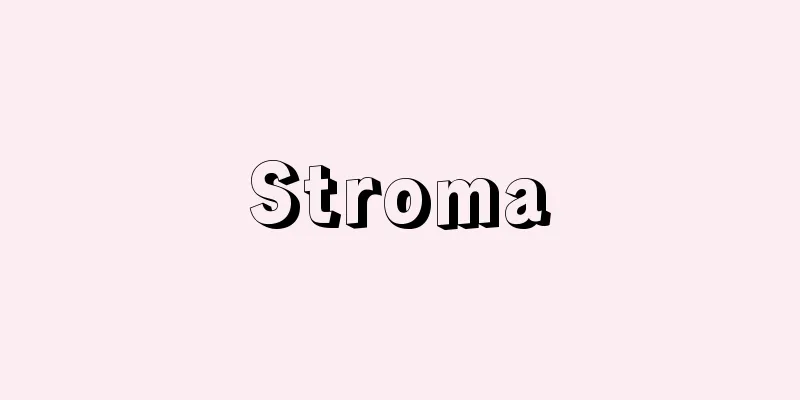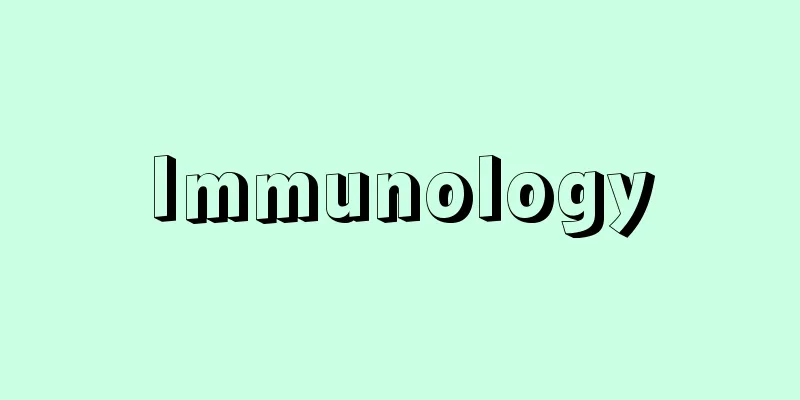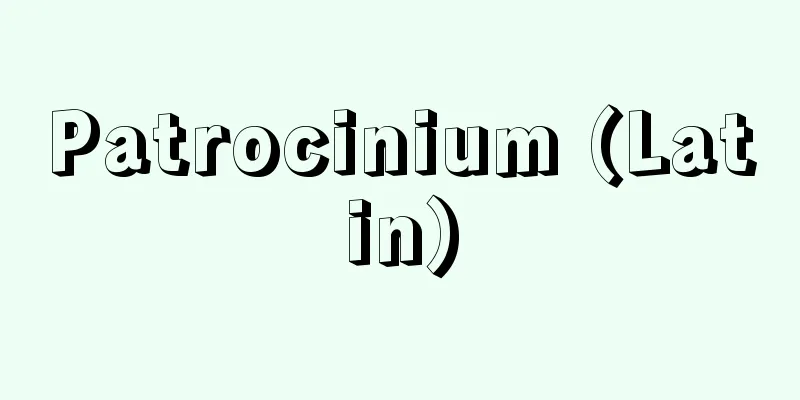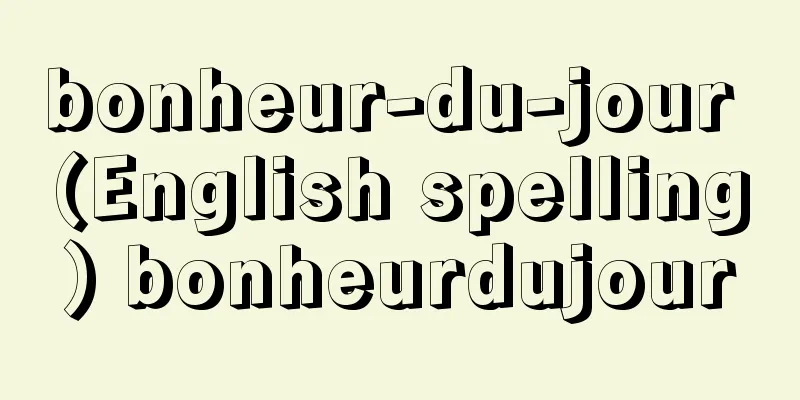Neuralgia - Shinkeitsuu (English spelling)
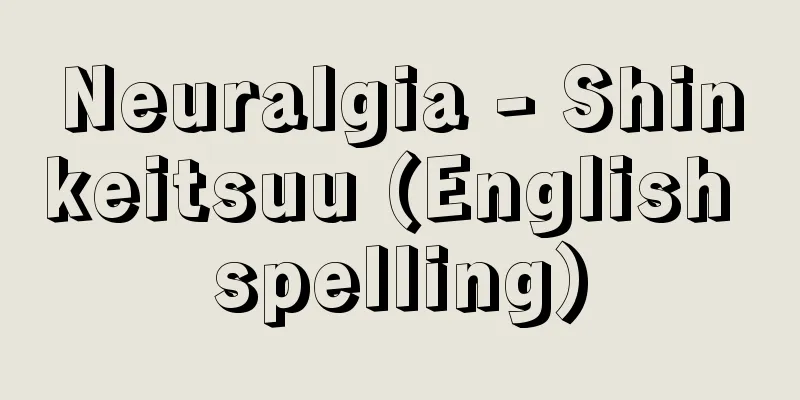
|
◎ There are symptomatic and idiopathic types [What kind of disease is it?] ◎ First, check for changes in bones [Testing and diagnosis] ◎ Treating the cause is the first priority [Treatment] [What kind of disease is it?] Pain occurs when the peripheral nerves, which control thermal and pain sensations such as pain, heat, and cold, are stimulated. The most common of these painful diseases is neuralgia, a disease that has been known for a long time and is familiar to most people, but not all pain is neuralgia. Medically, neuralgia is defined as pain that has the following characteristics: ① The area of pain corresponds to the area controlled by a single peripheral nerve. ② Sharp, intense pain occurs suddenly (paroxysmal), usually lasts for a short time, from a few seconds to a few minutes, and even if it subsides, it tends to recur (recurrent). 3) After the pain has subsided, pressing the peripheral nerve area where pain is occurring with your finger causes pain (the presence of a tender point). 4) When the pain has subsided, stimulating the skin or mucous membrane where the pain is caused with your fingers will induce pain (trigger band). ⑤ The pain is triggered by certain postures, coughing, sneezing, etc. Another characteristic of neuralgia is that it tends to occur in people middle-aged or older. ●Classification of neuralgiaNeuralgia is classified into symptomatic neuralgia (secondary neuralgia), where the cause is known, and idiopathic neuralgia (primary neuralgia, true neuralgia), where the cause is unknown. The reason for this classification is that the treatment varies depending on which category it falls into: if the cause is identified, fundamental treatment is possible, whereas if the cause is unknown, treatment will mainly focus on the symptom of pain. ■ Symptomatic neuralgia (secondary neuralgia) This is neuralgia, which is caused by lesions that stimulate the peripheral nerves and cause pain during examinations and tests, such as bone deformation, inflammation of the nerves and their surrounding areas (such as shingles), tumors, degeneration, and trauma. Although the person himself is often unaware of it, thorough examination often reveals movement disorders, muscle atrophy (wasting), as well as rashes, sensory disturbances such as numbness, tightness, and stiffness, and reflex disorders. Idiopathic neuralgia (primary neuralgia, true neuralgia) This is neuralgia, where no lesion causing pain can be found even after thorough examination and testing. In this case, the name of the disease is generally based on the peripheral nerve causing the pain. This name may be used as a temporary name until the underlying disease is identified, and once that disease is identified, the name may be changed to that disease. Below, we will explain the main types of neuralgia. Although the painful area and symptoms vary, the tests and treatments are almost the same for all types of neuralgia, so we will summarize the tests and treatments at the end. Testing and diagnosis "reference). Trigeminal neuralgia Glossopharyngeal neuralgia Occipital neuralgia Geniculate ganglion pain Pterygopalatine ganglion pain Vagus nerve pain Atypical facial pain Brachial neuralgia Intercostal neuralgia Femoral neuralgia Obturator neuralgia Sciatica Trigeminal neuralgia It is a severe neuralgia that causes pain on one side of the face. Since the pain is felt in the face, this neuralgia is commonly known as facial neuralgia, however, the facial nerve is a motor nerve that moves the facial muscles, and so you do not feel pain even if this nerve is stimulated. Therefore, facial neuralgia is incorrect and the correct name is trigeminal neuralgia. The trigeminal nerve is divided into three branches on both the left and right sides of the face: the first branch (ophthalmic nerve), the second branch (maxillary nerve), and the third branch (mandibular nerve) (see figure "Distribution of the trigeminal nerve"). Pain often occurs in the areas controlled by the second and third branches. The pain may extend into the areas controlled by adjacent nerves, and may be felt as far as the back of the head or shoulders, which are controlled by spinal nerves. Symptoms: A sharp pain described as stabbing, burning, or cutting occurs suddenly on one side of the face. The pain is often caused by yawning, sneezing, talking, chewing, washing the face with water, or blowing cold air. ●CauseIt is mentioned as a typical example of idiopathic neuralgia, the cause of which is unknown, but upon closer examination, it may be found to be a tumor or aneurysm in the brain stem, a symptom of multiple sclerosis ("multiple sclerosis"), or an aftereffect of shingles ("shingles"). ● Surgery If there is compression of small arteries in the brain stem, the back of the head is cut open and a surgical microscope is used to shift the compressing blood vessels and decompress the nerves (neurovascular decompression), but recurrence may occur in rare cases. There is also a method of inserting a needle into the trigeminal ganglion and passing a high-frequency current through it. Glossopharyngeal neuralgia The stabbing pain is a type of neuralgia that occurs mainly in the back of the tongue and pharynx (throat), and the pain reaches the ears. The pain is often triggered by chewing, swallowing, or talking, and is more common in middle-aged men. Occipital neuralgia This is neuralgia caused by stimulation of the dorsal root nerve coming out of the second cervical spinal cord, and pain occurs in the back, parietal, and temporal areas of one side of the head. The area that hurts is just about the size of the palm of the person's hand. The pain is triggered by neck movements, sneezing, coughing, etc. A characteristic of this condition is that even after the pain has subsided, there is a tender point that hurts when you press your fingertips 1 to 2 cm outside the protuberance in the center of the back of the head. It is relatively common among the elderly, and is often caused by deformities of the cervical vertebrae such as degenerative cervical spondylosis (cervical spondylosis) ("cervical spondylosis") or whiplash injury. Geniculate ganglion pain This is a rare type of neuralgia caused by damage to the ganglion (a thickened area made up of nerve cells) that receives the nervus intermedius, a sensory branch of the facial nerve. The most common cause is shingles (herpes zoster). The pain is mainly felt in the ear canal, but also extends from deep inside the ear to the deep parts of the face, causing facial paralysis on the same side. When this geniculate ganglion pain is accompanied by facial paralysis, tinnitus, and hearing loss, it is called Ramsay Hunt syndrome (herpes oticus (ear herpes)/Ramsay Hunt syndrome (Hunt syndrome)). Pterygopalatine ganglion pain This is neuralgia caused by irritation of the pterygopalatine ganglion, which receives the second branch of the trigeminal nerve. It is characterized by pain in the lower part of the face, as well as pain that resonates from the nose to the ears. It may be accompanied by runny nose, tears, and saliva secretion, and may be referred to as atypical facial pain ( Atypical facial pain It is considered to be a type of neuralgia that belongs to the pediatric nervous system. It is a rare type of neuralgia that is often seen in menopausal women. In addition, inflammation of the nasal cavity can irritate the pterygoid nerve, causing pain in the teeth and ears. This is called pterygoid neuralgia, but it is also rare. Vagus nerve pain This is a neuralgia that causes pain in the external auditory canal, eardrum, base of the tongue, and throat, which are located in the areas affected by the sensory branches of the vagus nerve. Atypical facial pain The pain occurs in the face and resembles trigeminal neuralgia, but it is a completely different type of neuralgia. What is the disease? "). The pain occurs on both sides of the face and is accompanied by autonomic nervous system symptoms such as tearing, nasal discharge, nasal congestion, and facial flushing. This type of neuralgia is relatively common among young women, and the pain can get worse or worse with changes in emotions, mood, and weather. Brachial neuralgia This is a relatively common type of neuralgia that causes pain over a wide area, including the neck, shoulder, arm, and hand on one side. The pain is often caused by a lesion in the brachial plexus, where various peripheral nerves extending from the neck to the hand converge.As a result, the pain occurs over a wide area, and unlike other types of neuralgia, the pain often lasts for a long time or becomes a dull ache. The pain becomes worse when pressing the hollow above the collarbone, and the pain can be induced by raising the arm straight and upward behind, stretching the brachial plexus. Causes: The most common causes are compression of the nerves and blood vessels in the neck due to deformation of the cervical vertebrae (cervical spondylosis) such as degenerative cervical spondylosis (cervical spondylosis) and thoracic outlet syndrome (thoracic outlet syndrome), and it often occurs in people who overuse their shoulders, arms, and hands, such as key punchers. Of the peripheral nerves that extend from the neck to the hand, the ulnar nerve passes behind the elbow, and the median nerve passes at the wrist, between the bones and ligaments around the joints, so if changes occur in these tissues, the peripheral nerves can be compressed or pinched, causing nerve damage. This is called entrapment neuropathy, and can also cause numbness and pain. Intercostal neuralgia The intercostal nerves are peripheral nerves (thoracic spinal nerves) that emerge from the back (thoracic spinal cord) and distribute throughout the chest and abdomen; there are 12 on each side, for a total of 24 (12 pairs). The seven pairs in the upper part (closer to the neck) extend along the ribs toward the sternum (the long vertical bone in the center of the chest). The five pairs in the lower part (nearer the abdomen) extend forward and downward, and are distributed throughout the abdomen. Pain felt along these intercostal nerves is called intercostal neuralgia, and is a common type of neuralgia. Symptoms: Sudden, severe pain occurs along the spine (backbone) and one rib on one side. There are often tender points along the ribs and on the rectus abdominis (abdominal muscles) that are painful when you press them with your fingers. The pain can be induced by taking a deep breath, coughing, shouting, or by bending the body toward the non-painful side, stretching the intercostal nerves. ●Causes The most common causes are spinal diseases such as lumbar spondylosis (degenerative lumbar spondylosis (lumbar degenerative spondylosis)) and shingles (shingles). It may be related to diseases of the chest organs such as pleurisy, pneumonia, or lung cancer, so if the symptoms persist, it is important to visit an internal medicine doctor to determine the cause. Femoral neuralgia This is neuralgia that affects the front of the thigh, and is usually caused by compression of the femoral nerve due to a femoral hernia. It is more common in middle-aged women. Obturator neuralgia This is neuralgia that affects the center of the inside of the thigh and is caused by an obturator hernia. The majority of patients appear to be elderly women. Sciatica The sciatic nerve is the largest and longest peripheral nerve, and its lower part branches into the peroneal nerve and tibial nerve, providing sensation to a wide area from the back of the thigh to the foot. Therefore, when this nerve is irritated, it can cause pain in one side of the buttocks, back of the thigh, and calf, and the pain can extend down to the heel and ankle. Symptoms: Even when you are resting, some pain often continues. The pain radiates downwards when you cough or sneeze, and the pain gets worse when you bend your body. In addition to pain, other symptoms that may occur include numbness in the lower limbs (legs), loss of sensation, abnormal tendon reflexes, and difficulty walking. When lying on your back and trying to raise your straight legs up to vertical, you experience severe pain in the back of your thigh and are unable to fully raise your legs (Lasegue's sign). In addition, in order to reduce the pain, people often put their weight on the unaffected lower limb and bend their body to the side (sciatic scoliosis). ● Causes This is a representative symptomatic neuralgia, and is usually caused by irritation, compression, or infiltration of the sciatic nerve due to a herniated disc, a tumor (cancer, etc.) in the spine, or lumbar spondylosis. Shingles, diabetes, alcoholism, etc. can also be the cause. [Testing and diagnosis] Neuralgia is often caused by bone changes such as deformation, especially of the spine (backbone), which puts pressure on or irritates the roots of the peripheral nerves that arise from the spinal cord, so X-rays of the spine are taken. In order to examine changes in bones in more detail, imaging diagnostics such as tomography, which can image parts of the body as layers of a certain thickness, CT or MRI, which can image cross-sections of the body, and contrast methods, which involve injecting a contrast agent to produce a clear image, may be performed. If the cause is thought to be a tumor or inflammation, an isotope (radioactive substance) may be injected and a scintigram may be performed to show the affected area. We may also examine the function of the peripheral nerves by performing electromyograms and measuring peripheral nerve conduction velocity. If you have a systemic disease such as diabetes, blood and urine tests will also be required. [Treatment] If it seems to be neuralgia, you should see an internal medicine or neurology specialist. If it is caused by bones, you should see an orthopedic surgeon. The first priority is to find the cause and treat it, but it is common to also receive the following treatments for neuralgia: ● Rest and protection therapy If pain occurs, do not push yourself and take a rest. Maintain a position that will relieve pain the most and try to stay calm. Avoid applying cold to the painful area, avoid spicy foods and drinks such as coffee, alcohol, tobacco, and spices, and try to eat foods rich in vitamins. If you become constipated, the pain will increase when you strain, so it is important to regulate your bowel movements and avoid constipation. Once the pain is gone, try doing some gentle exercise. ● Drug therapy: The use of antipyretics and analgesics, non-steroidal anti-inflammatory drugs, muscle relaxants, anticonvulsants, vitamins, vasodilators, etc. can help relieve pain. It can be taken orally, as a suppository, or by injection. Physical therapy is a type of treatment mainly performed in orthopedic clinics, and includes traction therapy to remove stress from the area where the cause of pain is, wearing a corset or cervical collar to immobilize the painful area and keep it still, as well as various methods for warming the painful area (bathing, infrared radiation, etc.). ●Acupuncture and moxibustion therapy This is a treatment that uses acupuncture and moxibustion to stimulate pressure points and reduce pain, and can be quite effective for some people. Nerve block: This is a treatment in which an anesthetic is injected into the painful peripheral nerve to relieve pain. This can be received at anesthesiology departments that run pain clinics (Column "Pain Clinic"). ●Surgery : Surgery is the first treatment for herniated discs and tumors of the spine or spinal cord, but whether or not surgery is necessary is carefully considered. If your doctor recommends surgery, listen carefully to the explanation and make a decision. Source: Shogakukan Home Medical Library Information |
|
◎症候性(しょうこうせい)と特発性(とくはつせい)とがある [どんな病気か] ◎骨の変化をまず調べる [検査と診断] ◎原因の治療が先決 [治療] [どんな病気か] 痛みは、痛さ、熱さ、冷たさなどの温痛覚(おんつうかく)をつかさどる末梢神経(まっしょうしんけい)が刺激されておこります。 この痛む病気の代表格が神経痛で、古くから知られ、なじみの深い病名ですが、痛めばすべて神経痛というわけではありません。 医学的には、つぎのような特徴がみられるときに、神経痛といいます。 ①痛む部位が、1本の末梢神経の支配領域に一致している。 ②鋭く、激しい痛みが突然おこり(発作性(ほっさせい))、持続時間が、ふつう、数秒~数分と短く、いったんはおさまっても、再発をくり返す(反復性)。 ③痛みのおさまっているときに、痛みの生じる末梢神経の部位を指で押すと痛みがおこる(圧痛点(あっつうてん)の存在)。 ④痛みのおさまっているときに、痛みの生じる皮膚や粘膜(ねんまく)を指で刺激すると痛みが誘発される(引(ひ)き金帯(がねたい))。 ⑤特定の姿勢をとったり、せき、くしゃみなどをしたりすると痛みが誘発される。 そのほか、発症が中年以降の人に多いことも神経痛の特徴です。 ●神経痛の分類 神経痛は、原因のわかる症候性神経痛(続発性神経痛)と原因のわからない特発性神経痛(原発性神経痛、真性神経痛)とに分類されています。 このように分類しているのは、原因がわかれば根本的な治療が可能になるのに対し、原因がわからなければ、痛みという症状に対する治療が主になるなど、どちらに属するかによって治療の内容がちがってくるからです。 ■症候性神経痛(しょうこうせいしんけいつう)(続発性神経痛(ぞくはつせいしんけいつう)) 診察や検査で、末梢神経を刺激して痛みをおこしている病変、たとえば、骨の変形、神経およびその周囲の炎症(帯状疱疹(たいじょうほうしん)など)、腫瘍(しゅよう)、変性、外傷(がいしょう)などが見つかる神経痛です。 本人は自覚していないことが多いのですが、綿密な検査を行なってみると、運動障害、筋肉の萎縮(いしゅく)(やせ細り)のほか、発疹(ほっしん)、しびれ、突っ張り、こわばりといった知覚障害、および反射の障害が証明されることが少なくありません。 ■特発性神経痛(とくはつせいしんけいつう)(原発性神経痛(げんぱつせいしんけいつう)、真性神経痛(しんせいしんけいつう)) 綿密に診察や検査を行なっても、痛みをおこす病変が見つからない神経痛です。 この場合、一般に痛みをおこしている末梢神経の名称を冠した病名が用いられます。 この病名は、原因となっている病気が見つかるまでのとりあえずの病名として用い、原因となる病気がはっきりすれば、その病名に切り替えられることもあります。 以下におもな神経痛について解説しますが、痛む部位や症状はちがっても、行なわれる検査や治療はほぼ同じなので、検査と治療は、最後にまとめて述べることにします(「検査と診断」参照)。 三叉神経痛(さんさしんけいつう) 舌咽神経痛(ぜついんしんけいつう) 後頭神経痛(こうとうしんけいつう) 膝状神経節痛(しつじょうしんけいせつつう) 翼口蓋神経節痛(よくこうがいしんけいせつつう) 迷走神経痛(めいそうしんけいつう) 非定型的顔面痛(ひていけいてきがんめんつう) 上腕神経痛(じょうわんしんけいつう) 肋間神経痛(ろっかんしんけいつう) 大腿神経痛(だいたいしんけいつう) 閉鎖神経痛(へいさしんけいつう) 坐骨神経痛(ざこつしんけいつう) 三叉神経痛(さんさしんけいつう) 顔面の片側が激しく痛む神経痛です。 顔面が痛むことから、この神経痛は、俗に顔面神経痛(がんめんしんけいつう)とも呼ばれているようですが、顔面神経は、顔の筋肉を動かす運動神経であって、この神経が刺激されても痛みを感じるということはありません。 したがって顔面神経痛は誤りで、三叉神経痛が正しい病名です。 三叉神経は、顔面の左右ともに、上から第1枝(眼神経(がんしんけい))、第2枝(上顎神経(じょうがくしんけい))、第3枝(下顎神経(かがくしんけい))の3本に分かれていますが(図「三叉神経の分布」)、痛みのおこるのは、第2枝と第3枝の支配領域のことが多いようです。 隣接する神経の支配領域まで痛みが響き、脊髄(せきずい)の神経の支配領域である後頭部や肩まで痛みを感じることがあります。 ●症状 刺しえぐるようだ、焼けるようだ、切られるようだなどと表現される鋭い痛みが、顔面の片側に突然おこります。あくび、くしゃみ、会話、物をかむ、水による洗面、冷風などが刺激となって、突然、痛み出すことが多いものです。 ●原因 原因のわからない特発性神経痛の代表にあげられていますが、よく調べてみると、脳幹(のうかん)に腫瘍や動脈瘤(どうみゃくりゅう)が発見されたり、多発性硬化症(たはつせいこうかしょう)(「多発性硬化症」)の症状であったり、帯状疱疹(たいじょうほうしん)(「帯状疱疹」)の後遺症(こういしょう)であったりします。 ●手術 脳幹部に小動脈の圧迫がある場合は、後頭部を切開し、手術用顕微鏡を使って、圧迫している血管をずらして神経を減圧します(神経血管減圧術(しんけいけっかんげんあつじゅつ))が、まれに再発することがあります。三叉神経節に針を刺して、高周波電流を流す方法もあります。 舌咽神経痛(ぜついんしんけいつう) 刺すような痛みが、舌の奥、咽頭(いんとう)(のど)を中心におこる神経痛で、痛みが耳にまで響きます。 物をかむ、飲み込む、話をするといったことをきっかけとして痛み出すことがよくあります。中年の男性に比較的多くみられるものです。 後頭神経痛(こうとうしんけいつう) 第2頸髄(けいずい)から出る後根神経(こうこんしんけい)が刺激されておこる神経痛で、片側の後頭部、頭頂部、側頭部にかけて痛みがおこります。ちょうど、その人の手のひらでおおえるぐらいの範囲が痛みます。 くびの運動、くしゃみ、せきなどで痛みが誘発されます。 痛みがおさまっているときでも、後頭の中央にある隆起部の1~2cm外側を指で押すと痛む圧痛点があるのが特徴です。 高齢者に比較的多く、変形性頸椎症(へんけいせいけいついしょう)(頸部変形性脊椎症(けいぶへんけいせいせきついしょう))などの頸椎(けいつい)の変形(「変形性頸椎症(頸部変形性脊椎症)」)やむち打ち症が原因のことが多いものです。 膝状神経節痛(しつじょうしんけいせつつう) 顔面神経の知覚枝である中間神経を受ける神経節(神経細胞が集合して太くなっている部分)の障害による神経痛で、頻度はまれです。 帯状疱疹(たいじょうほうしん)(「帯状疱疹」)が原因になることが多いものです。 耳の孔(あな)を中心に痛みますが、耳の奥から顔面の深部も痛み、同じ側の顔面まひがおこります。 この膝状神経節痛に顔面まひ、耳鳴(みみな)り、難聴(なんちょう)をともなったものを、ラムゼー・ハント症候群(「耳性帯状疱疹(耳ヘルペス)/ラムゼー・ハント症候群(ハント症候群)」)といいます。 翼口蓋神経節痛(よくこうがいしんけいせつつう) 三叉神経(さんさしんけい)の第2枝を受ける翼口蓋神経節が刺激されておこる神経痛です。顔面下部の痛みとともに、鼻を中心に耳へ痛みが響くのが特徴です。 鼻汁(びじゅう)、涙、唾液(だえき)の分泌(ぶんぴつ)をともなうことがあって、非定型的顔面痛(ひていけいてきがんめんつう)(「非定型的顔面痛」)に属する神経痛と考えられています。まれな神経痛で、更年期の女性に多くみられます。 さらに、鼻腔(びくう)の炎症が翼突管神経(よくとつかんしんけい)を刺激し、歯、耳に痛みが響くことがあります。これをビデアン神経痛といいますが、やはり、まれです。 迷走神経痛(めいそうしんけいつう) 迷走神経の知覚枝の分布する外耳道(がいじどう)、鼓膜(こまく)、舌根(ぜっこん)、のどが痛む神経痛です。 非定型的顔面痛(ひていけいてきがんめんつう) 痛みが顔面におこり、三叉神経痛(さんさしんけいつう)に似ていますが、まったくちがう神経痛です。神経痛の特徴(「どんな病気か」)を示しません。 痛みが顔の両側におこり、涙や鼻汁(びじゅう)の分泌(ぶんぴつ)、鼻づまり、顔面紅潮などの自律神経(じりつしんけい)の症状をともないます。 若い女性に比較的多くみられる神経痛で、感情、気分、気候の変化により、痛みが強くなったり、弱くなったりします。 上腕神経痛(じょうわんしんけいつう) 片側のくび、肩、腕、手と広い範囲に痛みがおこる比較的多い神経痛です。 くびから手のほうへ伸びるいろいろな末梢神経(まっしょうしんけい)が合流している上腕神経叢(じょうわんしんけいそう)という部分の病変が痛みの原因のことが多く、このため、広い範囲が痛み、ほかの神経痛とちがい、痛みが長く続いたり、鈍い痛みになったりすることも少なくありません。 鎖骨(さこつ)の上のくぼみを押すと痛みが強くなり、腕を伸ばしたまま後ろ上方に上げ、上腕神経叢を伸ばすようにすると痛みが誘発されてきます。 ●原因 変形性頸椎症(へんけいせいけいついしょう)(頸部変形性脊椎症(けいぶへんけいせいせきついしょう))などの頸椎(けいつい)の変形(「変形性頸椎症(頸部変形性脊椎症)」)、胸郭出口症候群(きょうかくでぐちしょうこうぐん)(「胸郭出口症候群」)などによるくびの部分の神経や血管の圧迫が原因になることが多く、キーパンチャーなどの肩、腕、手を酷使する人によくおこります。 くびから手のほうに伸びている末梢神経のうち、尺骨神経(しゃっこつしんけい)は肘(ひじ)の後ろ、正中神経(せいちゅうしんけい)は手くびのところで、それぞれ骨や関節周囲の靱帯(じんたい)の間を通るため、これらの組織に変化がおこると、末梢神経が圧迫されたりはさまれたりして神経障害がおこります。これを捕捉性(ほそくせい)ニューロパチー(「末梢神経障害(ニューロパチー)」)といい、このときにも、しびれや痛みがおこります。 肋間神経痛(ろっかんしんけいつう) 肋間神経は、背中(胸髄(きょうずい))から出て、胸腹部に分布する末梢神経(まっしょうしんけい)(胸髄神経(きょうずいしんけい))で、右側と左側のそれぞれに12本、計24本(12対)あります。上部(くびに近いほう)の7対は、肋骨に沿い、胸骨(きょうこつ)(胸の中央に縦に長く触れる骨)に向かって伸びています。下部(腹部のほう)5対は、前下方に向かって伸び、腹部に分布します。この肋間神経に沿って痛むのが肋間神経痛で、頻度の高い神経痛です。 ●症状 脊椎(せきつい)(背骨(せぼね))から片側の1本の肋骨に沿って、激しい痛みが突然おこります。 肋骨に沿った部位や腹直筋(ふくちょくきん)(腹部の筋肉)の上に、指で押すと痛みのおこる圧痛点が存在することが少なくありません。 深呼吸、せき、大声などで痛みが誘発されるほか、痛みのない側へからだを曲げ、肋間神経を伸ばすようにしても痛みが誘発されます。 ●原因 変形性脊椎症(へんけいせいせきついしょう)(「変形性腰椎症(腰部変形性脊椎症)」)などの脊椎の病気や帯状疱疹(たいじょうほうしん)(「帯状疱疹」)が原因になることが多いものです。 胸膜炎(きょうまくえん)、肺炎、肺がんなどの胸部の内臓の病気が関係していることがあるので、いつまでも続くときは、内科を受診して、原因をはっきりさせることがたいせつです。 大腿神経痛(だいたいしんけいつう) 大腿(太もも)の前面が痛む神経痛で、ふつう、大腿ヘルニアのために大腿神経が圧迫されておこります。 中年の女性に比較的多くみられます。 閉鎖神経痛(へいさしんけいつう) 大腿(だいたい)(太もも)の内側中央が痛む神経痛で、閉鎖管(へいさかん)ヘルニア(閉鎖孔(へいさこう))が原因でおこります。 患者さんは、高齢の女性が多いように思われます。 坐骨神経痛(ざこつしんけいつう) 坐骨神経は、最大最長の末梢神経(まっしょうしんけい)で、下部は腓骨神経(ひこつしんけい)と脛骨神経(けいこつしんけい)に分かれ、大腿(だいたい)(太もも)後面から足部にかけての広い範囲の知覚をつかさどっています。 このため、この神経が刺激されると、片側の臀部(でんぶ)、大腿の後面、ふくらはぎが痛み、かかとやくるぶしのほうまで痛みが響くことがあります。 ●症状 安静にしているときでも、多少、痛みが続いていることが多いものです。せき、くしゃみなどで痛みが下方にまで響き、からだを曲げたりすると痛みが強くなります。 痛みのほかに、下肢(かし)(脚(あし))のしびれ、知覚の鈍麻(どんま)(にぶさ)、腱反射(けんはんしゃ)の異常、歩行障害などがみられることが少なくありません。 あおむけに寝て、まっすぐ伸ばした下肢を垂直になるまで上げていくと大腿の後面に激しい痛みがおこり、十分に下肢を立てることができません(ラセーグ徴候(ちょうこう))。 また、痛みを軽減するため、痛まないほうの下肢に体重をかけ、からだを横に曲げた姿勢になることも多いものです(坐骨神経痛性側弯(ざこつしんけいつうせいそくわん))。 ●原因 症候性神経痛の代表で、たいていは、椎間板(ついかんばん)ヘルニア、脊椎(せきつい)(背骨(せぼね))の腫瘍(しゅよう)(がんなど)、腰部変形性脊椎症(ようぶへんけいせいせきついしょう)などのために、坐骨神経が刺激・圧迫・浸潤(しんじゅん)されておこります。帯状疱疹(たいじょうほうしん)、糖尿病、アルコール依存症などが原因のこともあります。 [検査と診断] 神経痛は、変形などの骨の変化、とくに脊椎(せきつい)(背骨(せぼね))が変形し、脊髄(せきずい)から派生してくる末梢神経(まっしょうしんけい)の根もとが圧迫されたり、刺激されたりしておこることが多いので、脊椎のX線撮影が行なわれます。 骨の変化をより詳細に調べるために、人体の部位をある厚さをもった層として撮影できる断層撮影(だんそうさつえい)、人体を輪切りの状態にして撮影できるCTやMRI、造影剤(ぞうえいざい)を注入して、はっきり映し出す造影法などの画像診断が行なわれることもあります。 腫瘍(しゅよう)や炎症が原因と考えられるときは、アイソトープ(放射性物質)を注入し、病変部を映し出すシンチグラムが行なわれることもあります。 筋電図や末梢神経伝導速度の測定などを行なって、末梢神経のはたらきを調べることもあります。 糖尿病などの全身性の病気のあるときは、血液や尿の検査なども必要になります。 [治療] 神経痛らしいときは、内科か神経内科を受診します。骨に原因があるときは、整形外科の担当になります。 原因を探し、それを治療するのが先決ですが、つぎのような神経痛の治療も行なわれるのがふつうです。 ●安静保護療法(あんせいほごりょうほう) 痛みがおこったら、むりはせずに休養をとります。 もっとも痛みが和らぐ姿勢を保ち、安静を心がけます。 痛む部位を冷やさないようにし、コーヒー、アルコール、たばこ、香辛料などの刺激の強い飲食物の摂取を避け、ビタミン類の豊富な食品をとるように心がけます。 便秘になると、いきんで痛みが強くなりますから、便通を整え、便秘にならないようにすることもたいせつです。 痛まなくなったら、軽い運動をするようにします。 ●薬物療法 解熱鎮痛薬(げねつちんつうやく)、非ステロイド抗炎症薬、筋弛緩薬(きんしかんやく)、抗けいれん薬、ビタミン剤、血管拡張薬(けっかんかくちょうやく)などの使用が痛みを和らげます。 使用法は、内服や坐薬(ざやく)のほか、注射のこともあります。 ●理学療法 おもに整形外科で行なわれる治療法で、痛みの原因が存在する部位の負担を除く牽引療法(けんいんりょうほう)、痛む部位を固定して安静を保つコルセットや頸椎(けいつい)カラーの装着のほか、痛む部位を温めるためのいろいろな方法(入浴や赤外線照射など)が行なわれます。 ●鍼灸療法(しんきゅうりょうほう) 鍼(はり)や灸でいわゆるつぼを刺激し、痛みを抑える治療法で、人によっては、かなり効果があります。 ●神経ブロック 痛みのおこる末梢神経に麻酔薬を注入し、痛みを止める治療法です。 ペイン・クリニック(コラム「ペイン・クリニック」)を実施している麻酔科で受けられます。 ●手術 椎間板(ついかんばん)ヘルニア、脊椎(せきつい)や脊髄(せきずい)の腫瘍(しゅよう)などは、手術がいちばんの治療ですが、手術が必要かどうか、慎重に検討されます。 医師から手術を勧められたときは、説明をよく聞いて決断しましょう。 出典 小学館家庭医学館について 情報 |
<<: Neurotransmitters - Neurotransmitters
Recommend
Kiss
〘noun〙 (kiss)⸨kissu⸩① (as an expression of affecti...
Goshikidai
A plateau-like mountain range facing the Seto Inl...
Déry (English spelling) Déry Tibor
Hungarian novelist. Born into a wealthy Jewish fa...
William Styron
American author. Born in Newport News, Virginia, ...
Common cold syndrome
…Fever usually lasts for 3 to 5 days. Infectious ...
Heavy oil - Jyuyu (English spelling) fuel oil
A type of fuel oil, it is called heavy oil becaus...
Card Tax - Koppaizei
〘 noun 〙 A national tax levied on items such as Ir...
Kielholz, P.
...The combination of these symptoms colors the i...
Lambuth, Walter Russell
Year of death: September 26, 1921 Born: November 1...
drama
...However, the scope of meaning differs between ...
Responding body - King
A Buddhist term. A Chinese translation of the San...
Atropine
A type of alkaloid found in plants of the Solanac...
Katano Monogatari - Tale of a Tale
…In the Tale of Genji and Ochikubo Monogatari, he...
Sangama
…1336-1649. It was succeeded by four different ro...
Geranium shikokianum (English spelling) Geraniumshikokianum
…[Mitsuko Shimizu]. … *Some of the terminology th...

